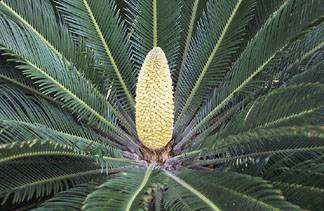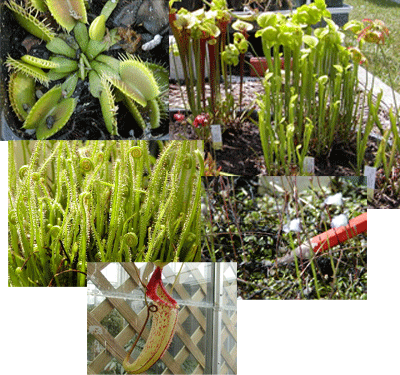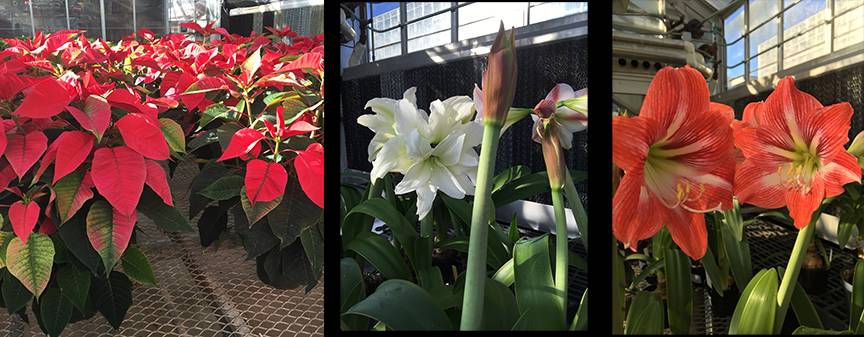Are you a hothouse flower crying out for heat and humidity now that December has opened its icy grey arms? A tropical forest — yes really! — awaits you inside the campus Conservatory, prized showcase of the Plant Biology greenhouses at 1201 South Dorner just north of the Pennsylvania Ave. tennis courts. Bring your lunch and warm your limbs on a welcoming bench by the tiny pond with its miniature waterfall and lily pads. Savor the scents of exotic blossoms, ever so carefully labeled for that educational infusion.

This week there’s a particular reason to stop by the Conservatory.
On Thursday, December 3rd from 3-6 p.m. and Saturday, December 5th from 10 a.m.-12 p.m., you’ll find the annual holiday sale of blooms and greens, many of them grown on site.
 Poinsettias, amaryllis, Christmas cactus, ferns and more are there to entice you, lovingly tended by Debbie Black, dedicated research specialist and greenhouse manager since 1996. Her degree and professional experience in horticulture serve us all well. She graciously hosts pre-school through high school tours, the occasional Art + Design drawing class, a dance troupe seeking rainforest inspiration, and sunlight-starved souls needing to breathe deep on a bleak day. Visit growing chocolate and bananas in the Conservatory. Here Black points out the odd green fruit soon to ripen to dark sweetness on a Jaboticaba, native to Brazil.
Poinsettias, amaryllis, Christmas cactus, ferns and more are there to entice you, lovingly tended by Debbie Black, dedicated research specialist and greenhouse manager since 1996. Her degree and professional experience in horticulture serve us all well. She graciously hosts pre-school through high school tours, the occasional Art + Design drawing class, a dance troupe seeking rainforest inspiration, and sunlight-starved souls needing to breathe deep on a bleak day. Visit growing chocolate and bananas in the Conservatory. Here Black points out the odd green fruit soon to ripen to dark sweetness on a Jaboticaba, native to Brazil.

Black delights in sharing the current rare blossoms, ongoing highlights such as the epiphyte tree, concocted of PVC pipe to host an array of orchids, and other odd bits of information about the some 208 plant species and 69 families represented in this gem of a compact glassed-in space, tall enough to accommodate full a full-grown Queen Sago palm, one of the seven species of cycads given to Plant Biology in the 1920s by Prof. Charles Chamberlin, professor of Botany at the University of Chicago. A particular interest of Black’s are species grown for trade: you can see coffee, sugar, shampoo ginger, and the plants behind the epic Dutch spice trade in the specialty greenhouse collections: cardamom, allspice, pepper, nutmeg, cloves and cinnamon.
Built in 1988 as part of the Plant Biology Laboratory, the Conservatory is a particularly magical space on campus, open to anyone on weekdays from 8:30 a.m.-4:30 p.m., with extended hours for the sale this week. The passions of the students and staff keep the place lively. Check their website for the latest news on what’s flowering, and better yet to see the webcam view from a few years back: the spectacular inflorescence of the Corpse Flower, with appropriate orchestral accompaniment. You can admire without its namesake smell of rotting meat the time-lapse opening of an immense burgundy bloom on this Amorphophallus titanium, or “misshapen giant phallus.”
 Are you a fan of Aubrey Jr. in the cult classic film The Little Shop of Horrors? Visit the greenhouses beyond the Conservatory for a closer acquaintance with the appetites of carnivorous plants. These are uniquely adapted to boggy peat environs that have been leached of nitrogen, necessary for healthy plant growth. A number of species have evolved ways to trap insects to supply the needed nitrates. You can study up close the anatomy of the Venus Fly Trap, native to North and South Carolina, named Dionaea muscipula by Carl Linnaeus after Diana, the Greek goddess of love and beauty. Each dionaea grows trapdoor mechanisms on modified leaves, sweetened deep inside with nectar to lure hungry insects. When an unsuspecting bug agitates the trigger hairs guarding the sweet stuff, the trap slams shut and the plant releases digestive enzymes similar to those in your stomach. They dissolves the soft portions of the insect, leaving the exoskeleton to blow away once the trap re-opens. Researchers in biomechanics study the amazing swiftness of the strike of a venus flytrap — .1 of a second once two trigger hairs are stimulated — to inspire man-made applications.
Are you a fan of Aubrey Jr. in the cult classic film The Little Shop of Horrors? Visit the greenhouses beyond the Conservatory for a closer acquaintance with the appetites of carnivorous plants. These are uniquely adapted to boggy peat environs that have been leached of nitrogen, necessary for healthy plant growth. A number of species have evolved ways to trap insects to supply the needed nitrates. You can study up close the anatomy of the Venus Fly Trap, native to North and South Carolina, named Dionaea muscipula by Carl Linnaeus after Diana, the Greek goddess of love and beauty. Each dionaea grows trapdoor mechanisms on modified leaves, sweetened deep inside with nectar to lure hungry insects. When an unsuspecting bug agitates the trigger hairs guarding the sweet stuff, the trap slams shut and the plant releases digestive enzymes similar to those in your stomach. They dissolves the soft portions of the insect, leaving the exoskeleton to blow away once the trap re-opens. Researchers in biomechanics study the amazing swiftness of the strike of a venus flytrap — .1 of a second once two trigger hairs are stimulated — to inspire man-made applications.
 There’s an interesting connection with bioengineering research on campus. Prof. Yuhang Hu researches the qualities of the secretions of pitcher plants, the Sarracenia species. They have evolved a gel that is sticky for insects to walk into the plant on, but becomes slippery, propelling them inward to a nectar that intoxicates the insect so it won’t escape. Bioengineers apply the secrets of Sarracenia to man-made hydrogels, for some useful applications.
There’s an interesting connection with bioengineering research on campus. Prof. Yuhang Hu researches the qualities of the secretions of pitcher plants, the Sarracenia species. They have evolved a gel that is sticky for insects to walk into the plant on, but becomes slippery, propelling them inward to a nectar that intoxicates the insect so it won’t escape. Bioengineers apply the secrets of Sarracenia to man-made hydrogels, for some useful applications.

There’s enough in a visit to the Conservatory to hold your interest and revitalize your winter-afflicted skin and spirit. Put it on your calendar to explore over a picnic lunch. And be careful not to get too close to the Venus flytrap.








